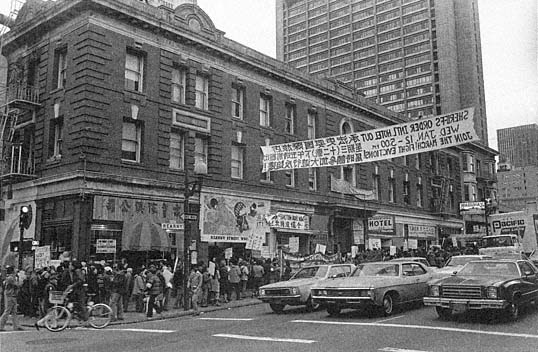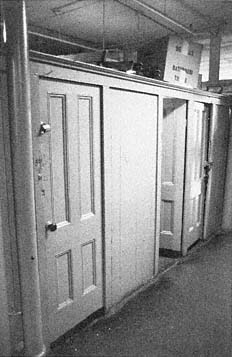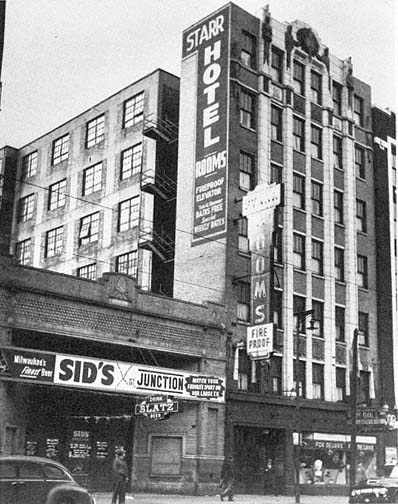Fronts for Embarrassing Economic Realities
The contrast between the core of downtown and any one of the single laborers' districts rarely failed to jar streetcar and automobile travelers. An equally sharp boundary existed between the facades and interiors of the cheapest hotels. Before 1900, the architectural exteriors of lodging houses usually matched interior conditions. The exteriors of the

Figure 5.22
San Francisco's International Hotel, photographed in 1977 as demonstrators fought to stop its demolition.
The handsome design of the 1907 facade contrasts strongly with its spare lodging house interiors.
run-down, cheaply constructed wooden lodging houses of the nineteenth century stood out like sore thumbs. They were sore thumbs: social embarrassments, cultural concerns, and architectural eyesores. However, between 1900 and 1920, with no single great inducement, thousands of landowners in American cities were building more polite facades for their lodging houses, exterior images that matched the new commercial world of downtown. The new structures of course reflected production peaks, especially those of World War I. Yet there seemed to be new cultural rules for these buildings.
Keeping in step with national trends, landowners in San Francisco built remarkably schizophrenic lodging houses. The facades and interiors were disassociated; the exterior design and building materials said little or nothing about the uses of the upper floors or the people who lived inside them (fig. 5.22).[72] The interiors of lodging houses were the most reliable material clues to the social and economic standing of their initial residents. The extreme plumbing ratios, minimum air wells, lack of furniture, and narrow hallways made residents immediately and constantly aware not only of their income but also of their place in society (fig. 5.23). Especially for white and American-born workers, the interiors of cheap lodging houses reinforced their cultural alien-

Figure 5.23
Surviving cubicles in a Bowery Hotel.
When photographed in 1986, the area
was being used for storage.
Note articles resting on the wire
ceilings of the cubicles.
ation from the rest of urban society.[73] As capital investors saw it, the interiors of cheap lodging houses were embarrassing necessities for agricultural and industrial production and for commercial and transportation service. In contrast to the interior conditions, the architectural exteriors could easily have been mistaken for lofts or small office buildings of the period.
Admittedly, institutional forces nudged the owners along in their decisions to build in this way. New building codes and their efficient enforcement brought grudging interior changes.[74] But beyond specifying brick construction to stop fires and enforcing various height and bulk limitations to guide building density, neither city nor state bureaucracies had stipulated that owners of purpose-built lodging houses commission the construction of nice facades. Indeed, "nice" is the word for the lodging house facades built after 1900: they were dressed up, made more presentable than their forebears (fig. 5.24). The phenomenon was notable in both rooming houses and lodging houses but more remarkable in the cheaper hotels.
The presentable yet schizophrenic facades built after 1900 were one strategy used by landlords to erase embarrassing images of the social and economic marginality in their properties, and to erect reassuring

Figure 5.24
A dressed-up lodging house facade in Chicago, contrasting with a more
literal side view. Photographed in 1954.
images of greater cultural uniformity. Of course, landowning citizens also built polite exteriors for individual and personal reasons: for future flexibility and better resale values, for personal pride, or for the desire to be more high-minded business people. The new lodging house facades offered the potential for casual workers' neighborhoods to appear to be respectable, minimally threatening, and permanent. Choosing to give cheap hotels facades that were commercial and not residential was an attempt at making them culturally acceptable both to their residents and to outsiders. The public could imagine that the people inside the new buildings were perhaps not so drastically different a subculture as first-floor sidewalk scenes suggested. For outsiders, at least, the respectability of nice facades visually linked the workers' low-
priced hotel subcultures to the high-priced environments of the dominant culture. The resident hoboes could appear to share with business people the bridge of commercial culture. For the hoboes themselves, the exterior architectural images might also have helped them to feel more a part of the great commercial core of the metropolis.
For their part, the architects of cheap lodging houses (or, more probably, the skilled drafters working for small contracting firms) also exerted their professional and personal desires for a more elegant city, even though their powers for individually influencing buildings of this class were extremely limited. These structures were economically destined to be generic buildings. In reality, the designers' most essential contributions rested in making the floor plans work while getting the most rentable space out of a cramped downtown site.
The schizophrenic relationship of the lodging house facades and their interiors declared that these sorry material conditions were probably the best that the urban political economy of that era could do—reasonably dress up the front and nominally clean up the interiors. It is significant that the owners dressed up the fronts by their own initiative, while the slower improvement of interior standards required a vigilant network of professional reformers and a succession of political battles.
The quality of life and the eventual life spans of cheap lodging houses were thus linked not only to the employment of their residential customers but also to the work of reformers and a specific generation of owners—the people who, after the turn of the century, built hotel life more permanently than it had ever been before. These improvements notwithstanding, in the eyes of politicians, the public, and professional reformers, neither the interiors nor the facades of any lodging houses would ever be adequate. The critics did not want lodging houses and their residents to merge with the city but to vanish entirely. In fact, a coalition of critics intended to prove that no one should live in hotels of any kind—palace, midpriced, rooming house, or lodging house. Given their interests in the hotel business, the hotel property owners naturally stood to disagree. The wide range of the hotel industry itself would prove to work against their common interests.